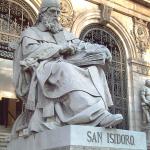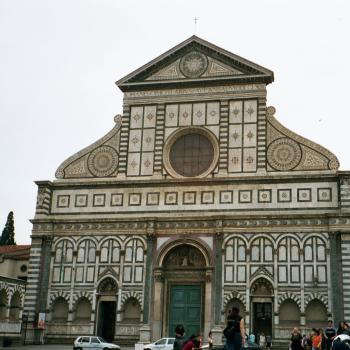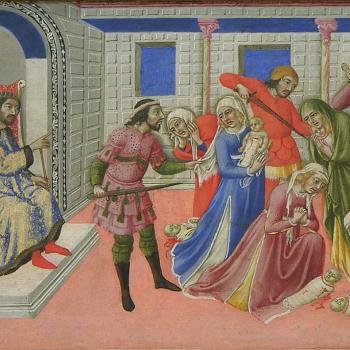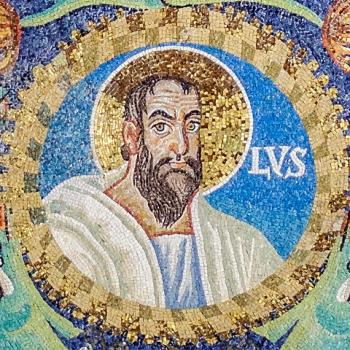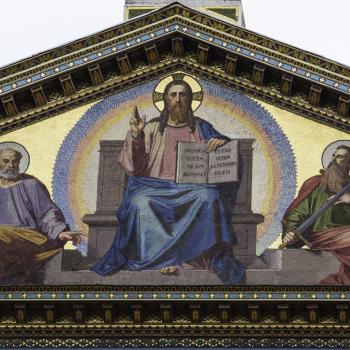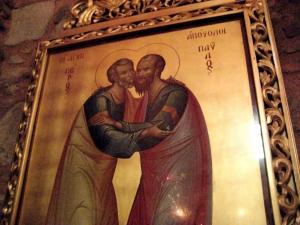
Working together, Sts. Peter and Paul built up the church and set up the foundation of the See of Rome. But it was not an easy task.
St. Peter struggled to understand what faith in Christ really meant, to see its universality, to see how it transcended his Jewish background. Peter was a man of faith, a man of devotion, but also a man who made many mistakes. And yet, like many great men, he was willing to learn from his follies.
St. Paul was a man of faith and vision, a universal vision. It was not easy for him. Originally, he denounced Jesus, but, thanks to what happened to him on the road to Damascus, he came not only to believe but to see what Jesus had come to do in the world. He came to understand the way of Christ transcended particulars while allowing for the good found in various particularities to find themselves fulfilled in Christ. Thus, Paul who once said that in Christ Jesus there is neither male nor female, Jew or Gentile (cf. Gal. 3:28) also said that in following Christ, he became all things for all people:
For though I am free from all men, I have made myself a slave to all, that I might win the more. To the Jews I became as a Jew, in order to win Jews; to those under the law I became as one under the law — though not being myself under the law — that I might win those under the law. To those outside the law I became as one outside the law — not being without law toward God but under the law of Christ — that I might win those outside the law. To the weak I became weak, that I might win the weak. I have become all things to all men, that I might by all means save some (1 Cor. 9:19-22 RSV).
Paul pointed the way which Peter found it difficult to traverse; even when Peter understood it was what was intended for him and the church, he struggled with it in himself. He found himself in an unusual situation as the church grew: more and more Gentile converts were coming to him, looking to him for advice, while Jewish believers like him still felt tied to their Jewish heritage. It divided Peter: even when he knew what was right, he could be drawn in from pressure to return to his old ways. Paul was, in this sense, the thorn at Peter’s side which Peter needed:
But when Cephas came to Antioch I opposed him to his face, because he stood condemned. For before certain men came from James, he ate with the Gentiles; but when they came he drew back and separated himself, fearing the circumcision party. And with him the rest of the Jews acted insincerely, so that even Barnabas was carried away by their insincerity. But when I saw that they were not straightforward about the truth of the gospel, I said to Cephas before them all, “If you, though a Jew, live like a Gentile and not like a Jew, how can you compel the Gentiles to live like Jews?” (Gal. 2:11-14 RSV).
Hellenists and Hebrews were both trying to figure out the new faith and all its implications, and in doing so, they liked to keep to their old ways as much as possible. This caused conflict, consistent conflict, in the early church. We like to think of the early community of believers as an ideal utopian society which only later broke apart into conflict, but soon after Pentecost, the human factor entered the equation, and Christians were struggling with Christians, apostles with apostles, trying to figure out the faith and how to live it properly. Peter was confronted by Paul, not on doctrinal issues – Peter clearly affirmed the doctrines which Paul taught – but with his way of life, and it was important because Peter was the head of the church. Without Paul, perhaps, he would not have been able to do it properly. Without Paul by his side – nagging him to do the right thing – Peter could easily have forgotten a large portion of the flock which he had been given to feed, and that would have stunted the church at its inception. This, among other reasons, is why Peter and Paul are properly linked together, not just as co-apostles, but also as founders of the See of Rome. Paul, even in conflict, worked with Peter to make sure the church in Rome was universal in its status so it could continue on after them to lead the growing, and ever greater church in the future. St. Irenaeus was right in linking Peter and Paul together as the ones who founded the See of Rome. In this respect, St. Ambrose, with great insight, was able to say Paul was not inferior to Peter:
Nor was Paul inferior to Peter, though the latter was the foundation of the Church, and the former a wise builder knowing how to make firm the footsteps of the nations who believed; Paul was not, I say, unworthy of the fellowship of the apostles, but is easily comparable with the first, and second to none. For he who knows not that he is inferior makes himself equal.[1]
This equality can be understood as the foundation for their work together, for it allowed them to be more than co-workers, but friends. This might be surprising to some, as it often seems that Peter and Paul were in conflict with each other. But that conflict has to be understood within the proper context. St. John Chrysostom, reading Paul talk about how he stayed with Peter, understood that this implied they formed a close bond of friendship:
See what great friends he was with Peter especially; on his account he left his home, and with him he tarried. This I frequently repeat, and desire you to remember, that no one, when he hears what this Apostle seems to have spoken against Peter, may conceive a suspicion of him. He premises this, that when he says, “I resisted Peter,” no one may suppose that these words imply enmity and contention; for he honored and loved his person more than all and took this journey for his sake only, not for any of the others.[2]
Paul, then, confronted Peter with love and respect; it was a contention of friends, of Paul looking out for Peter and helping him, not denigrating him or his position or authority in the church. Paul did not deny Peter’s doctrinal authority. Paul did not start a campaign against Peter, saying that he had done wrong, was a heretic, and should have his authority removed from him. He did not question Peter’s faith. He only encouraged Peter to live it out to the fullest, to see the Gentile converts as being among those neighbors Christ has told his followers to love and respect. There is something very Jewish in this, for it was an ancient Jewish understanding to think of those “strangers” or “sojourners” mentioned in the Torah as representing Gentile converts to the Jewish faith, so that they should not be neglected by being foreign-born.[3] Paul only took this notion further by changing the expectations placed upon converts, to see Jesus and the New Covenant did not require converts to strictly follow the Mosaic Covenant.
Peter recognized the truth in Paul’s message, but he also understood how difficult it was to comprehend; there problem is something Petrine coming out of 2 Peter when the author wrote:
And count the forbearance of our Lord as salvation. So also our beloved brother Paul wrote to you according to the wisdom given him, speaking of this as he does in all his letters. There are some things in them hard to understand, which the ignorant and unstable twist to their own destruction, as they do the other scriptures (2Ptr. 3:15-16 RSV).
Peter trusted Paul, despite their conflicts. The Petrine tradition recognized the validity of Paul while pointing out that Paul’s transcendent, universal sense could be, and was, capable of being misrepresented and misapplied – such as was done with many Gnostics who used some of Paul’s writings to denounce the whole Jewish tradition. Paul was a Jew who loved his Jewish heritage, and its influence can be seen throughout all his writings: his universalism itself had a Jewish foundation, just it took on a new shape with Jesus.
Peter and Paul, then, were to come together and perish together in Rome in the time of Nero. Two men, born into the Jewish faith, promoted the most universal nature of their Jewish faith, pointing to the fulfillment of that universalism in Jesus Christ. Peter was a fisherman turned leader; Paul was a scholar turned missionary and mystic. They had different roles, different duties, and yet they had the same role and duty: the promotion and development of the early Christian faith. They are celebrated together because together, and not apart, were they capable of fulfilling their mission. Together, in all the trials and tribulations, in all the joys and sorrows, they were able to form a bond of love and set up the initial foundation of the Roman See. We need to look to them, to recognize how conflicts do not need to destroy friendships, but can be used to create stronger bonds once they have been worked through. Two men, who might otherwise have not come together, now stand together, united in eternity.
O Lord, You have taken up to eternal rest and to the enjoyment of Your blessings the two divinely-inspired preachers, the leaders of the Apostles, for You have accepted their labors and deaths as a sweet-smelling sacrifice, for You alone know what lies in the hearts of men (Kontakion for the Feast of Sts. Peter and Paul).
[1] St. Ambrose, “On the Holy Spirit” in NPNF2(10): 135.
[2] St. John Chrysostom, “Commentary in Galatians” in NPNF1(13): 13.
[3] See for example, Reuven Hammer, trans. and ed., The Classic Midrash: Tannaitic Commentaries on the Bible (New York: Paulist Press, 1995), 412-14.
Stay in touch! Like A Little Bit of Nothing on Facebook.
If you have liked what you read, please consider sharing it with your friends and family!



